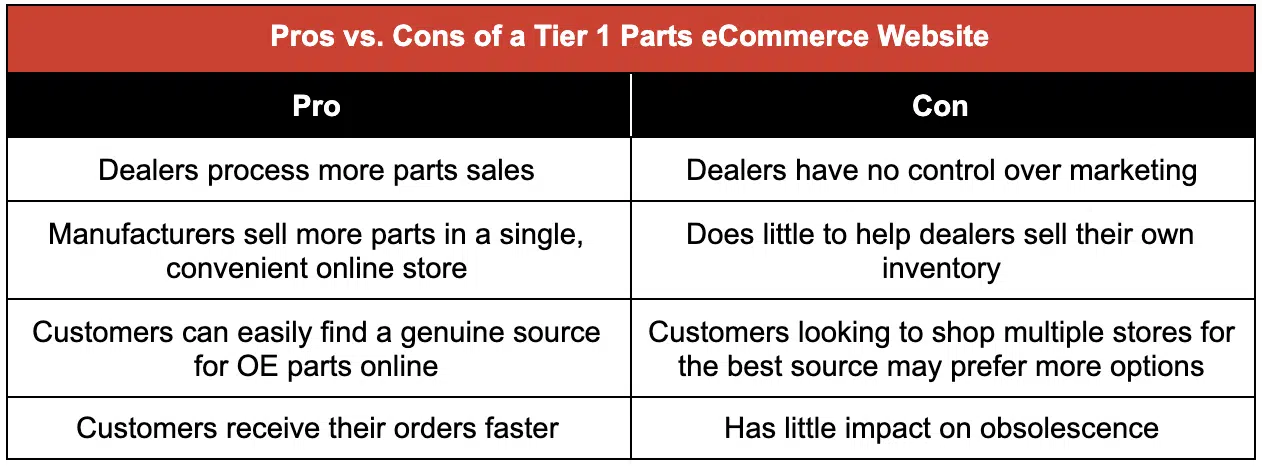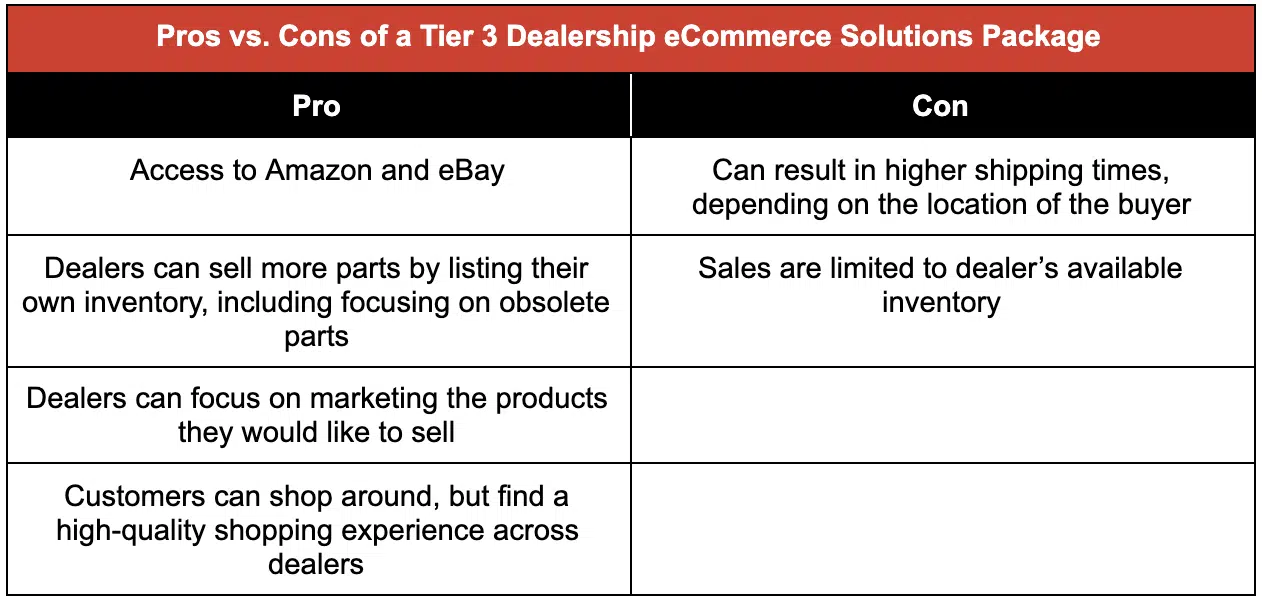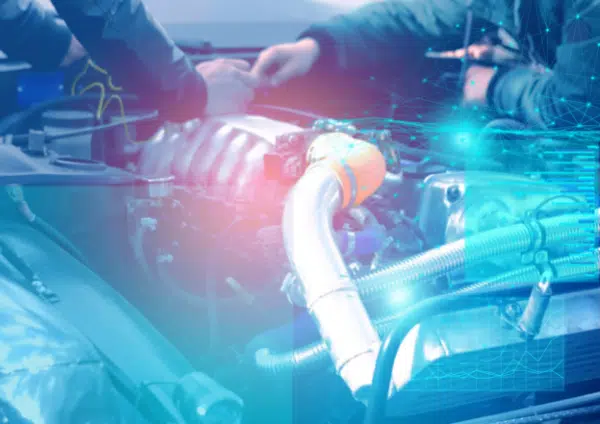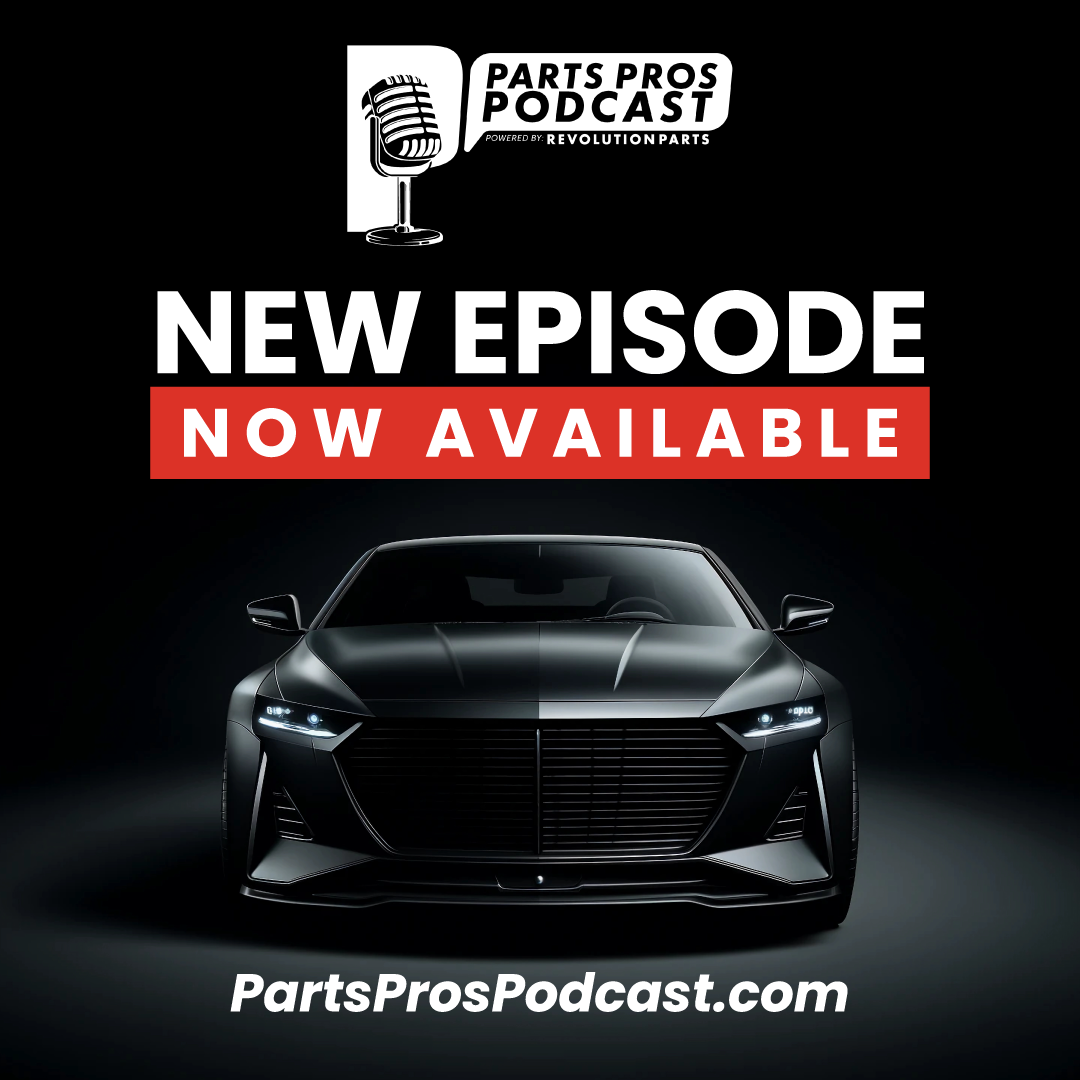Many automotive manufacturers have created recommended or mandated programs for use throughout their dealerships to promote the success of the individual dealership and the brand as a whole. OEM programs help manufacturers help their dealerships capture repeat customers and drive up revenue, create a unified experience across a brand, and create a better customer experience that promotes brand loyalty.
Recently, RevolutionParts surveyed over 200 dealers to determine how they felt about the current OEM programs throughout their dealership. Aside from discovering that OEM programs are used in the parts department more than anywhere else in the dealership, the report found that dealers were generally happy with their OEM programs. However, there was one issue dealers consistently struggled with: eCommerce. Over half the dealers surveyed felt their programs did not provide the eCommerce support their customers were looking for.
This insight provides an excellent opportunity for manufacturers to help their dealers capture a whole new audience of online shoppers and loyal repeat customers.
Why Every Automaker Should Have a Parts eCommerce Program
The parts department is one of the most likely places dealers are willing to implement an OEM program. While these programs seem to be working well for dealers, dealers agree that improvements can be made regarding eCommerce.
Until recently, the automotive industry, and the automotive parts industry, in particular, didn’t have much of a reason to invest in online retailing. After all, traditionally, most people interact with a dealership in person.
Over the past few years, the pressure for the auto industry to adapt to an online model to better suit the needs of customers who increasingly want to shop online has been growing. The need to adapt to an online model was never more apparent than in 2020 when the pandemic shut down cities across the country, causing a standstill in retail with new economic challenges upending the way dealerships traditionally do business: face-to-face.
While shutdowns in the US are no longer the norm, dealerships are still feeling the rippling effects of the pandemic as new car sales are down, both due to their increasing price and lack of availability due to the chip shortage. To make up for the loss in new car sales, dealerships are searching for ways to make up the lost income, and one area they are turning to is the parts department.
In 2020, dealerships across the U.S. lost over six billion dollars in parts sales. Yet, those selling parts online through RevolutionParts saw a 27% increase in parts sales, proving that parts eCommerce must be integral to any future dealer strategy. Manufacturers must adapt their parts programs to be more eCommerce friendly.
The Best Way for OEMs to Support Parts eCommerce
Automotive manufacturers understand the shift in buyer behavior and are quickly adapting to provide a modern solution for their dealerships. Many have already developed comprehensive eCommerce programs to help dealers sell vehicles online. The real question is not whether manufacturers should be offering an eCommerce solution in their parts departments, but instead how they can provide the best program, one that is beneficial to the dealer and to the manufacturer.
Manufacturers have many options when it comes to building their parts eCommerce program, including:
- Tier 1 National Parts eCommerce Website
- Tier 3 Dealership eCommerce Solutions Package
- Tier 1/Tier 3 Hybrid
Tier 1 Parts eCommerce Website
With a tier 1 program, manufacturers can take advantage of dealers to help them deliver OE parts to their customers. Having a tier 1 parts eCommerce program means setting up a national eStore where consumers can order parts, all from a single location.
The order placed at the national eStore is usually routed to the closest dealer to the customer to help ensure the customer receives the part as quickly as possible. Alternatively, a manufacturer leverages its own warehouses to fulfill some or all orders. The parts sales are then credited to the dealer. This is a win-win situation for the manufacturer looking to give customers a convenient and modern way to shop with fast delivery while also helping their dealers sell more parts. Qualified eCommerce solution providers can help manufacturers quickly launch a new Tier 1 Parts eCommerce website.

Tier 3 Dealership eCommerce Solutions Package
Another option for manufacturers is to partner with an eCommerce solution provider to create packages for Tier 3 Dealership stores.
The most significant advantage of a tier 3 option is that dealers are in charge of selling their own inventory, and the manufacturer does not have to drive the experience other than setting a set of standards for eCommerce sites to meet. The dealerships get an eCommerce solution that helps them sell more parts and increase revenue that is specific to the dealership. This means the dealer gets their own parts web store and access to multiple online marketplaces like Amazon and eBay. The manufacturer provides vetting of the solution provider and can support the solution through reimbursement or coop programs for dealers’ digital marketing and solution fees.

Tier 3 Dealership eCommerce Solutions Package
Another option for manufacturers is to partner with an eCommerce solution provider to create packages for Tier 3 Dealership stores.
The most significant advantage of a tier 3 option is that dealers are in charge of selling their own inventory, and the manufacturer does not have to drive the experience other than setting a set of standards for eCommerce sites to meet. The dealerships get an eCommerce solution that helps them sell more parts and increase revenue that is specific to the dealership. This means the dealer gets their own parts web store and access to multiple online marketplaces like Amazon and eBay. The manufacturer provides vetting of the solution provider and can support the solution through reimbursement or coop programs for dealers’ digital marketing and solution fees.
Tier 1/Tier 3 Hybrid Solution
The best parts program for any manufacturer to provide their dealers is a hybrid between tier 1 and tier 3. This is where the OEM has its own national eStore that can take advantage of dealers around the country to supply and ship products to customers ordering from the eStore.
Dealers also get to focus on running their own eCommerce business by having the opportunity to adopt a parts program that helps them sell their inventory on their own web store and have access to online marketplaces like Amazon and eBay. Dealers are also given access to specialized parts marketing to promote their web store.
It is clear that dealers want to take advantage of eCommerce and are ready for their OEMs to provide eCommerce support through OEM parts programs. Through a hybrid solution, dealers can provide this for their dealers while also reaping the benefits of a national eStore.

Building the Best OEM Parts Program: Partnering vs. Building Internally?
The truth is, building a program from the ground up is expensive and time-consuming. Manufacturers attempting to develop a program internally will face many challenges, including sourcing the needed technical expertise, investing time and resources in creating the program, and maintaining the program long-term. Manufacturers looking to upgrade existing parts programs or to develop new ones need to consider:
- Availability of expertise and resources
- Potential technological developments and security risks
- Length of time it takes to develop
- Desired control over brand messaging
- Overhead costs to creating a custom solution
Typically, an internally built program can take between one and three years to complete, and for most companies, that is the easy part. The biggest challenge is providing customer support for the program and maintaining it long-term. Over the next few years, software complexity is expected to rise significantly with the expectation of increased functionality, and more technical expertise will be needed to maintain and upgrade existing programs. There will also be growing security risks the manufacturer will need to contend with.
Instead of building a program internally from scratch, OEMs need to consider the benefits and ease of partnering with parts eCommerce experts, like RevolutionParts, to create custom programs that can launch in just a few months instead of taking years to develop and implement.
RevolutionParts partners with manufacturers to provide the most turnkey and full-featured parts eCommerce solutions. OEMs partnered with RevolutionParts to create a custom parts eCommerce Solution have seen significant increases in site traffic, purchase rate, average order value, and total revenue. Dealers have also been given access to specialized parts marketing, with the average dealer experiencing an 8.75X return on ad spend. By utilizing Artificial Intelligence, Machine Learning, and real-time reporting to identify marketing trends and customer behavior, RevolutionParts can help drive sales and increase revenue.
By partnering with RevolutionParts, manufacturers can expect a quick-to-market solution and an easy onboarding process for their dealers. OEMs interested in a custom-made parts eCommerce solution can contact us for a free consultation.




